The Future Of Neighborhoods: Five Projects That Show How We'll Live
Residential life could soon be changing.

Clear thinking: A partial rendering of ReGen Village, including glass greenhouses where food will grow year-round.
1. WE'LL GENERATE OUR OWN RESOURCES
An ambitious experiment in the Netherlands could be a model for life off the grid.
When a new housing development called ReGen Village opens as early as next year on the outskirts of Amsterdam, residents won’t have to rely on external sources to provide most of their energy, waste management, or even food. The village is designed to operate as a closed-loop system, meaning it meets most of its needs from within. "We are redefining residential real estate development by creating regenerative neighborhoods," says project mastermind James Ehrlich, a California-based developer and senior technologist at Stanford. "It’s very much attuned to the cycles of nature."
Though self-sufficiency is not a new idea—communities survived for centuries before there even was a grid from which to disconnect—Ehrlich hopes ReGen will serve as a testing ground for a concept that could help reduce global dependence on unsustainable resources. The village’s 200 homes and apartments will house about 600 residents. ReGen has partnered with Danish architecture firm Effekt to design the futuristic houses, which Ehrlich sees as a modern take on traditional Scandinavian aesthetics, featuring clean lines, lots of glass, and tall, steep roofs.
Though the Amsterdam ReGen community is aimed at luxury buyers, the idea is to eventually expand the closed-loop concept to the developing world, where self-sufficiency could have an even more profound impact by providing reliable sources of food and water. Ehrlich plans to use the proceeds from the first village to build similar towns for low-income residents in sub-Saharan Africa and rural India.
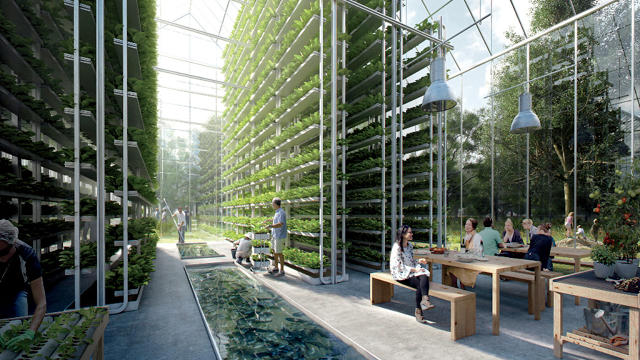
ReGen’s radical self-reliance will require a big assist from modern technology. High-yield organic growing methods—that include aeroponics, aquaponics, and food forests—will produce fruit, vegetables, legumes, and herbs year-round while using a fraction of the water and space that traditional farming practices require. Animal waste will be converted into electricity through a biomass generator, and a storage system will collect and process rainwater and graywater. If Ehrlich can make all of these efforts work together (along with more familiar eco techniques such as composting and solar energy), he believes his regenerative communities won’t just be self-sustaining—they will produce enough excess food and power that residents can sell the bounty to nearby neighborhoods, which will help to offset operating costs. In developing countries, that could prove significant both inside and outside the village’s borders. "A single ecovillage that’s producing more organic food and nutrient-dense soil than it needs [can help provide for] the surrounding community," Ehrlich says. "If you build enough of these, we can slowly prepare ourselves for the next 2 to 3 billion people coming to the planet."
Ehrlich acknowledges that the high-end clientele he’s targeting with the Amsterdam development probably won’t be able to live completely off the grid. In addition to amenities such as internet access and cable TV that can’t be produced on site, residents will have to look outside for luxuries like coffee, spices, and other food items. Homeowners will also likely produce some kinds of waste that the community can’t reuse, which will need to be carted away. But in poor areas, where needs are simpler but far more urgent, Ehrlich believes each village will be able to subsist entirely on its own. "It’s ambitious," says the developer, "but building regenerative-system thinking into neighborhoods is the only way for humanity to survive and thrive." —Adele Peters
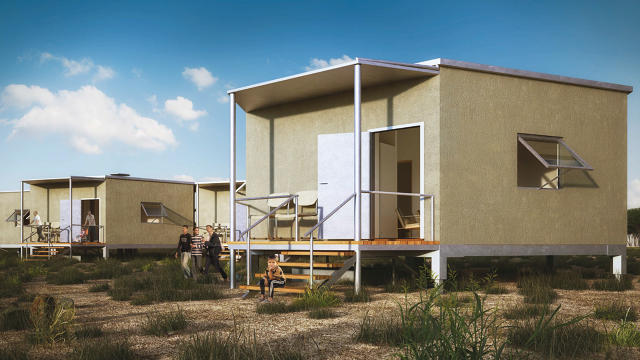
2. WE'LL RAISE THE STANDARD OF ULTRA-AFFORDABLE HOUSING
New shelters are designed to help refugees and others with limited means.
HEX HOUSE: Want to lower the barrier to homeownership? Reduce the cost of design and construction, which can account for roughly half the purchase price. That’s what Amro Sallam, executive director of the nonprofit design firm Architects for Society, aimed to do by creating the Hex House, a two-bedroom, 450-square-foot home kit that owners can assemble themselves on-site with simple tools, Ikea style. The approximately $15,000 structures, which he plans to begin selling next year, will be built out of structural insulated panels, which are light, strong, low-cost, and energy efficient. Sallam also plans to erect Hex House neighborhoods near cities that need more affordable housing. Residents would buy the house and a small parcel of land, and kits would be preassembled and shipped to the site.
IN MY BACKYARD: This past June, a team of Spanish and French architects from sustainable-housing firms Design of Architectural Territories Pangea (DAT Pangea) and Quatorze built the first two prototypes of In My Backyard in Paris. The tiny-home concept is intended to provide refugees with stable, energy-efficient housing on the properties of residents who volunteer to share their land. The refugees get more than just a place to live: Ricardo Mayor Luque, CEO of DAT Pangea, is developing partnerships with universities that will turn the building process into a training program. Refugees work with In My Backyard to construct their own abodes, learning skills that could help them find construction work in their adopted city. When training is done and the house is complete, they’ll even get a diploma.
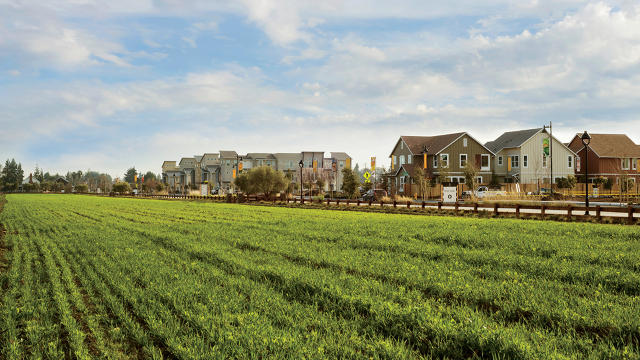
3. WE’LL GET BACK TO THE LAND
The demand for hyperlocal food is reshaping some suburban communities.
When residents of the Cannery walk out of their front doors, they are surrounded by 7.5 acres of farmland that’s flush with tomatoes, melons, and other produce, as well as a healthy brood of free-range chickens. In the distance, there’s a barn and a stand where passersby can purchase fresh baskets of crops. It sounds like life in the country, but the Cannery is located just two miles outside of the city of Davis, California. The community is one of a growing number of "agrihoods": urban and suburban housing developments that are constructed around working farms. "I’m a homebuilder, but the real joy is in building neighborhoods," says Kevin Carson, who oversees Northern California projects for Cannery developer the New Home Company. "A lot of communities get a golf course. We set out to create a master-plan community [around] food growing."
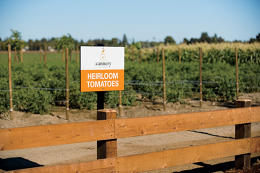
The Cannery—which opened in 2015 and currently has 77 occupied homes—is popular with both young families and retirees, who enjoy easy access to hyperlocal produce. (The agricultural operation is managed by the nonprofit Center for Land-Based Learning, which leases to private farmers.) "Agrihoods are part of the bigger movement of buy local, shop local, eat local," says Ed McMahon, a senior fellow at the Urban Land Institute, a nonprofit that advocates for responsible land use. "In our industrial economy, the growth of food was separated from where people live. People are reconnecting with where food comes from."
But the appeal goes beyond weekly boxes of squash and peppers. The concept of this and similar enclaves is that a farm can serve not just as a food source, but as the center of daily life. In addition to the crop fields, residents have access to a shared outdoor kitchen, enjoy fruit and nut trees in every yard, and meet up in an amphitheater that will hold community events such as concerts and festivals. Cannery resident Diane Parro says living there has changed not only how she eats—with family meals dictated by what’s in season—but also how she interacts with her neighbors. "We used to live in a large house with a sprawling yard that had a lot of upkeep, and we were really separated from the community," she says. "Now, we share a green lawn. We have potlucks at giant tables set up near people’s front doors, with local wine and deviled eggs from resident chickens. Food just tastes better when it comes right off a farm." —Jennifer V. Cole
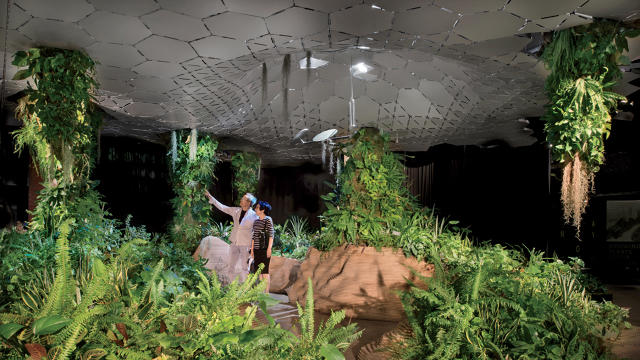
4. WE’LL BUILD IN UNEXPECTED SPACES
With cities growing ever more crowded, creative solutions will be key.
COPENHAGEN'S FLOATING DORMS: When Copenhagen entrepreneur Kim Loudrup couldn’t find affordable student housing for his son, he decided to create it himself. Along with renowned Danish architect Bjarke Ingels, he constructed Urban Rigger, an apartment complex made of modular shipping containers. The building sits on a floating base that the company pays to dock in Copenhagen’s harbor. Urban Rigger’s 15 studio apartments, which rent for $600, each have a private bedroom, bathroom, and kitchen, along with shared social space. "Most major postindustrial cities are experiencing some sort of a transformation and decline of their port industries," says Ingels. "Cities have increasingly available port areas that can be transformed. They could be the home for alternate forms of urbanization."
BANGKOK'S ASYMMETRICAL SOCCER FIELDS: In urban areas, room for athletic fields can be scarce. To provide a place for play, Bangkok-based real estate developer AP Thailand turned four odd-shaped lots into public fields. "We want to use our expertise in space management to create a space of happiness," says AP Thailand’s Pattaraphurit Rungjaturapat. Though FIFA fans might scoff at the irregular areas, players have started integrating the anomalies into their games, bouncing balls off of walls and using bends to maneuver around their opponents.
NEW YORK'S LOWLINE: The Highline—built on an abandoned elevated train track—is one of New York’s most popular parks. Could the next step be to move in the opposite direction? Cofounders James Ramsey and Dan Barasch are spearheading a project that would tap technology to build a 60,000- square-foot, plant-packed public park 20 feet below New York’s clogged streets. The idea—now being tested in a former supermarket—is to use aluminum-and-glass solar collectors to harness sunlight and redirect it to a distribution point via fiber-optic cables. A "solar canopy" of aluminum panels then distributes the plant-nurturing rays. In July, the city signed off on initial plans for the Lowline, though the team still needs to raise $10 million and secure another round of approval before work can begin (it attracted nearly $225,000 on Kickstarter to build the test lab). "By fusing an ancient, forgotten space with our collective future," says Ramsey, "we’re shaping a city I want my kids to live in."
5. WE’LL TURN DOWN THE HEAT
Madrid has a low-tech plan to cope with the impending effects of climate change.
Facing rising temperatures and frequent heavy downpours, the Madrid City Council will spend more than $4 million over the next year to cover many open spaces with plants. Here’s how it could help.
MORE COMFORTABLE AIR: When foliage was installed on rooftops and additional trees were planted along sidewalks near the Madrid airport, peak summertime air temperature fell by up to 8 degrees, due to increased shade and moisture in the air, which has a natural cooling effect.
FLOOD PROTECTION: The city plans to replace cement-covered city squares with small parks, which will be outfitted with planters that can absorb sudden rainfall and store it to use later for watering the foliage.
ENERGY EFFICIENCY: Many bare rooftops will be turned into gardens, and building facades will be coated with creeper plants. The greenery will act as insulation, reducing the amount of energy needed to cool homes.
No comments:
Post a Comment